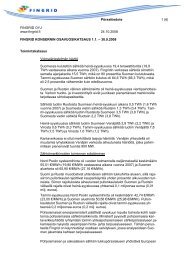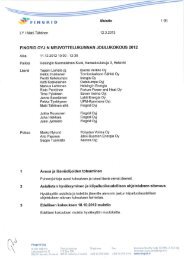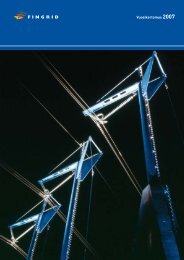Grid ABCThis article series deals with the main operating principles,equipment units and components in the main grid. The articlespublished in the series previously can be viewed on our websiteat www.fingrid.fi.Voltage in electricity transmissionand distribution systemsText by Jarmo Elovaara | Photograph by Juhani EskelinenThe technology applied to electricitytransmission is relativelyyoung: It was not until the early1880s that the conditions were createdfor the transmission of electricity overlonger distances. The alternating currentmotor was developed in those days, anda patent was granted for an idea wherethe voltage provided by a generator waschanged to a higher voltage for electricitytransmission, and back to a lowervoltage at the point of consumption sothat the electricity could be used.Since the generation and transmissionof electricity require considerablecapital, the related investments havehad a long life. In some countries, suchas Sweden, this has been reflected in therelatively great diversity of the voltagelevels used. Only in the past 40 to 50years has the electricity distribution systembeen rationalised by reducing thenumber of voltage levels used.The magnitude of the power transmittedas electricity is determined bythe voltage used and the current transmitted(P~ U·I). As electricity consumptionand transmission distanceshave increased, a need for higher andhigher transmission voltage levels hasemerged. The most viable voltage dependson both the power transmissionneed and the transmission distance.The general principle is: the longer thetransmission distance, the higher thetransmission voltage, but the voltagevalues are case-specific. The nature ofthe most advantageous voltage is suchthat it is better to overdimension ratherthan to underdimension the voltage (Figure1). As an example, when the voltageneeded to transmit a certain poweris doubled, the current value drops to ahalf, and the resistance losses occurringin the transmission line are reduced in asquare (~I 2 ), in other words to a quarterof the original. This improves the transmissionand distribution efficiency. Asmaller current also translates into asmaller cross-sectional area of the conductorand hence lighter and less expensiveconductors and towers, but inother respects an increase in the voltageincreases the size of the equipmentand also raises their price. Moreover, ahigher voltage usually also means fewerparallel lines in a certain link.The current travelling in the linecauses losses, which are manifested inboth power losses (heat) and in a voltagereduction in the line. Electricity distributionnetworks are so designed thatthe sum of the investment costs and losscosts needed to transmit the necessarypower is minimised. In high-voltagetransmission networks, however, thedistances are long, and attention mustbe paid to many other factors dependenton the voltage, such as the maximumtransmittable power without disturbingthe synchronous operation of differentgenerators in the network. This dependson the product of voltages affecting atthe ends of the transmission connection.The highest voltage used anywherein the world is usually also the highestoption that is technically and economicallyavailable. The technical constraintsare generally manifested in the currentbreaking capability of circuit breakersand in the maximum voltage withstandcapability of the insulations of equipment(including overhead lines). As thevoltages and currents increase, so do theenvironmental disadvantages and safetyrisks, such as the risk of a short circuitand earth fault. These must be kept undercontrol.In the early days of electricity use,there was limited technical knowledge,and the construction of large networkswas not mastered. This is why the decisivefactor in the selection of the voltagelevel was that the consumptiondevices would work as well as possible.Before the advent of alternating current(AC) motors, electricity was primarilyused for illuminating major cities. Thelamps were arc lamps powered by directcurrent, and a voltage of approx. 120volts (V) was optimal for them. The ACsystem devised in 1883 enabled highervoltage levels and the use of electricityin manufacturing industries. As theAC systems developed further, lampsequipped with a metallic glow filamentwere introduced in lighting. These couldbe used at a voltage about twice thevoltage of arc lamps. Nevertheless, thevoltage of the low-voltage network inmany Finnish towns in the early 20thcentury was still 110 volts.Arc lamps were apparently morecommon in America than in Europe.This is why low-voltage distributionin Europe and the USA started to usedifferent voltages, which are still inuse: The standard voltage in Europe is230/400 V, while in the United Statesand in countries that use the technologydeveloped there the standard voltage is120/208 or 120/240 V. The standardvoltage series for high voltage were notharmonised between Europe and Americauntil 2006.Figure 2 shows the transmission voltagein the AC network over the years,expressed as the rated voltage of thenetwork. The figure shows that whenmoving over to the use of a higher voltage,the ratio of voltages in consecutivevoltage levels is in the order of two dueFINGRID 2/<strong>2012</strong> | 32
Relative price / puto technical and economic reasons. Thehighest alternating voltage nowadaysused in overhead transmission lines forexample in Russia, Japan and China is1,000 to 1,200 kV (kilovolt, kV = 1,000volts). Cable networks have to make dowith a voltage which is about half ofthese, but the transmission connectionsemploying the highest voltages are usuallyso long that the use of cables is noteven possible in them, let alone economicallyviable.Direct current (DC) is used in verylong overhead transmission lines and insubmarine cable connections. DC connectionsare not as numerous as ACconnections, and standardisation doesnot give DC connections similar savingsas with alternating current. Thisis why the DC voltages are determinedby project-specific requirements andtechnological developments. The highesttransmission voltage in DC overheadlines is at present 800 kV, and approx.550 kV in DC cable connections.As the volume of electricity consumptionvaries, so does the magnitudeof voltage. In order to prevent excessivevoltage fluctuation, voltage mustbe controlled at the different pointsof the network. Voltage can be controlledin an interconnected network bymeans of synchronous machines andat transformer substations by changingthe number of windings on transformercoils (on-load and off-load tapchangers). In other parts of the network,voltage control employs control providedby compensation devices, in otherwords capacitors and reactors (“coils”),previously also by synchronous compensators(no-load synchronous machines).A capacitor raises while a reactordecreases the voltage.A properly connected combinationof reactors and capacitors can alsocater for matters affecting the qualityof electricity. Instead of conventionalcompensation devices controlled by acircuit breaker, there are now also compensationdevices operated by means ofpower semiconductors. These devicescan be controlled almost continuously.In addition to compensation, they canalso be used for changing the dynamicproperties of the network, such as addingattenuation after transients. Rated voltage of network (kV)14001200100080060040020010.750.50.250S=50 km525380220 28715 50 1101880 1900 1920 1940 1960 1980 2000 2020YearS=100 kmEconomically most suitabletransmission voltageS=200 kmS=400 kmS=600 km0 200 400 600 800 1000 1200 1400 1600Voltage of network U R/ kVFigure 1: Dependence of theprice of a transmission line ofa certain length on the voltage(solid line), and the optimumtransmission voltage(broken line) at differenttransmission distances in acertain situation. The priceis expressed as the specificcost, i.e. as a price scaled withrespect to the transmittedpower. The end result isshown as a relative value.Figure 2: Development of transmission voltage. In some countriesthe voltage of 380 kV has replaced 400 kV, and 300 kV or 365 kV areused instead of 287 kV.7351200From 7.8 to 400 kilovolts in 60 yearsThe first three-phase electricity transmission line of 8 kilometres and7.8 kilovolts (kV) in Finland was built in Ladoga Karelia in 1897 tofeed electricity for pumps, crushers, cableways and other equipmentused in the mining industry. The first power transmission system (15 kV and33 km) planned completely by Finns was introduced in 1900 between Säkkijärviand Vyborg in Karelia. The first 110 kV line in Finland was commissionedin 1929, transmitting the electricity generated at the Imatra rapidsin Eastern Finland via Southern Finland further to Turku on the west coast.Finland shifted to the 220 kV voltage level in the early 1950s. Swedenwas the first country in the world to introduce the 400 kV voltage in theearly 1950s, when power plants on the Luleå river were connected to theSwedish grid. Before that, the highest voltage anywhere in the world hadbeen 287 kV. Finland was also among the first countries to adopt 400 kVtransmission in the early 1960s.At the end of the 1970s, Sweden even made preparations for the useof a transmission voltage of 800 kV. However, a reduction in the growthof electricity consumption and intensified debate about the environmentaldrawbacks and potential health impacts of 800 kV transmission linesresulted in that the Swedish Government did not give a permit in 1980 tothe 800 kV line which had already been constructed between the Forsmarknuclear power plant and the Stockholm region.FINGRID 2/<strong>2012</strong> | 33

















